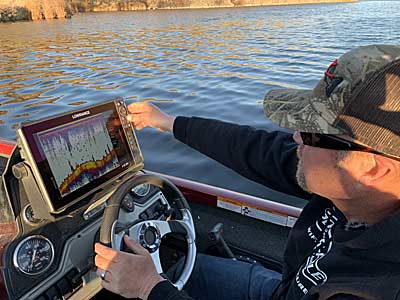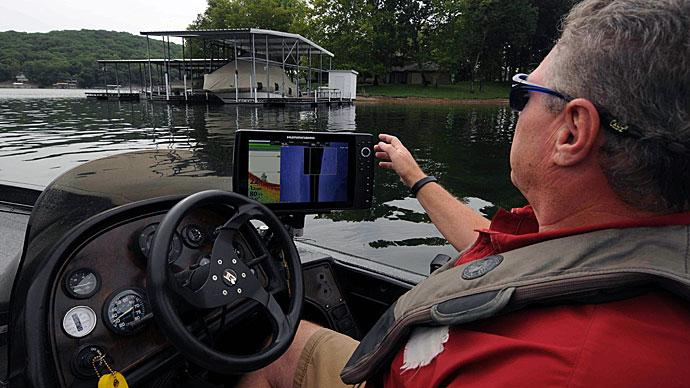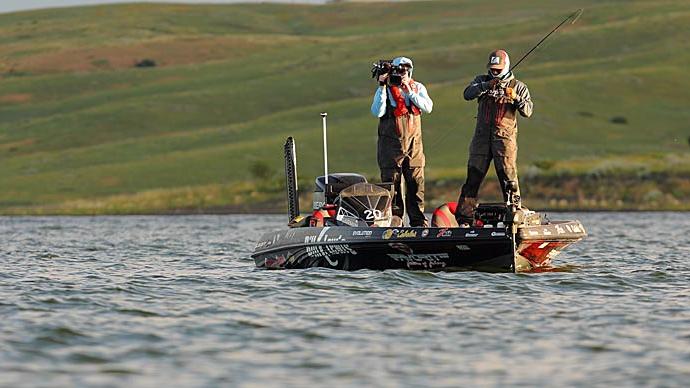
Advances in bass fishing over the past few years have been nothing short of astounding. The boats are bigger and faster, rods are more sensitive and lighter, trolling motors have as much thrust as small outboards, and lures are more lifelike and effective than ever.
The same is true with marine electronics. The days of flashers, a motor that vibrates the entire boat and makes that nerve-rattling noise, are long gone. It's simply amazing.
Technological advances have given us marine electronics that can see under the boat, to each side, and a live view in front of the boat with the advancement of forward-facing sonar.
Even the base model units available today are easy to read, very dependable, and relatively inexpensive. They have an exceptional definition with quality color screens that can be seen no matter the sun's position. It’s a significant change from how things were just a decade ago.
Understanding how sonar works is essential. Electrical impulses from the unit are sent to the transducer, which converts them into sound waves. The transducer sends these sound waves into the water in a controlled beam. Objects within this beam reflect the sonar to the transducer. The transducer accurately measures the distance to these objects based on the time it takes for the sonar to return. Each object (bottom, fish, or structure) reflects the sonar uniquely, providing information about its makeup. This information is then converted back into electrical impulses by the transducer and sent to the unit for display on the screen. How it is displayed is then interpreted by the user.
Underwater vegetation can confuse some depth finders because the sonar waves are diffused, absorbed, or reflected erratically. The fish finder needs to read through the hydrilla to the bottom so you will have an accurate depth. Bass in the hydrilla often relate to the bottom changes, so you must be aware of these changes.
If the top of the hydrilla is seven feet deep in 10 or even 17 feet of water, which is common during summer and fall, your fish finder must read through the top of the hydrilla to the bottom. There is a big difference between 10 and 17 feet because, quite often, bigger bass will relate to the bottom in the deeper hydrilla.
Now is probably a good time to talk about the cone angle. As stated before, the transducer sends down sonar waves. These waves are cone-shaped, narrow at the transducer, and broader as it gets deeper. As a rule of thumb, the bottom coverage is about one-third the depth. In other words, if you are sitting in 20 feet of water, the fish finder will cover a six-foot circle of the bottom under the boat. As you get deeper, this circle will get larger, and as you move shallower, the circle will be smaller.
Understanding this concept is critical in getting the most from your fishfinder. The shallower you get, the less likely you are to see a fish displayed on the screen simply because of the restricted coverage. As you idle through a shallow area, chances are you will spook a bass before it is displayed on the screen unless you use side-scanning technology. While in shallow water, it is vital to note bottom changes, cover, or structure that is likely to be holding bass. Chances are you will not see a bass on the screen in shallow water, but that does not mean they are not there. You have to fish the likely areas and assume that the bass are present.
A fish arch forms as the fish moves through the sonar beam. Due to the transducer beam angle, the distance to the fish decreases as it moves into the beam and increases as it moves out. When the chart window graphs this distance change, an arch appears. The boat speed and movement of the fish significantly affect the shape of the arch. When moving slowly, a fish creates an elongated arch. When moving fast, the arch appears shorter. A partial arch forms when the fish does not move through the entire cone. The longer a fish stays in the cone, the larger it will appear. A big bass may appear smaller if it is only on the edge of the cone. Also, a smaller bass may appear larger if it stays in the cone longer. In other words, the size of the arch does not necessarily correlate to the size of the fish.
Knowing the characteristics of bass and the type of water they prefer is critical in using a graph. Everything you see is not a bass. The sonar cannot distinguish between a gar, a carp, catfish, or a plastic jug, for that matter. If a fish appears close to the bottom on the edge of a drop-off or creek channel or close to cover, it probably is a bass. If the fish are away from cover, suspended over deeper water, or generally in areas that are not bass habitat, then they probably are not bass but some other kind of fish. Even if they are bass, the chances of catching them are not good. You would be better off going to a more likely area, where the bass are in a position to be caught. Bass that are close to the bottom, or cover, are fish that can be caught.
Installation of the transducer is the most critical aspect of getting a good readout on the screen. The sonar cannot read through the air. The best and most expensive unit will be rendered useless if the transducer is not installed correctly. Most bass boats now come as a package deal pre-rigged with fish finders. Most of the time, the transducers are mounted inside a designated area close to the transom. The transducer should be mounted outside the boat for the absolute best read-out. Usually, with this type of installation, you will lose some of the high-speed operations, but idling around over likely areas, will give the best picture. The front fish finder should have the transducer on the trolling motor. This will give you a picture of the bottom closer to where you are fishing in the front of the boat.
Interference from the trolling motor or another fish finder can cause a distorted picture and make you miss some critical information. Trolling motor interference can be eliminated by correctly grounding the trolling motor. If you have multiple units up front, they can be run simultaneously without interference if they are set to different frequencies.
Occasionally you will see fish and be able to catch them, and most often, this will be in water that is more than 15 feet deep. Most bass fishermen will fish in water less than 15 feet most of the time or vertically jigging in hydrilla where it is much more important to see the bottom than looking for fish in vegetation. You can become cross-eyed, nearly blind, and - trust me - your eyes will be watering before you can find a "blip" that looks like a fish if you sit in 15 feet of hydrilla.
Take the time to learn the areas you are fishing. Get a good map that shows the creek channels. Creek channels are the key to finding bass in most reservoirs. Once you have a map and have studied it, use the depth finder to locate these channels.
You will need set waypoints or use marker buoys to mark the bends, high spots, and brush. Idle with your boat in a zigzag manner to cross the channel back and forth. When you see a likely area, throw the marker or make a waypoint, and continue until you have the area mapped out.
You can use the same method to follow underwater points into the lake. As you zigzag across a point, mark the likely areas with buoys, so you understand the bottom contours well. This is the way you learn about a lake. It takes time, patience, and a good fish finder. Use a triangle method to line up the areas once you have found them. Line up a tree close to the shore with a tree further away to get an exact line on the spot. Do this even if you use a GPS. GPS units will get you close, but lining up trees or other objects will get you precisely on the spot. It doesn't hurt to mark these in a book for future reference. Do not rely on your memory for these exact lineups.
All of our modern fishfinders are a serious advancement in fish-finding technology. Combine this technology with some good common fish sense, and you are well on your way to finding more bass. Many people can catch bass if they find them, but not nearly as many people can find them!



